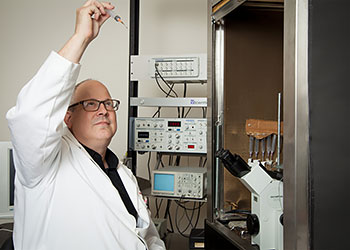TRPC6 Inhibitors a Promising Therapy
More than 20 million Americans are living with kidney disease, which is the ninth leading cause of death in the United States. More 600,000 are living with kidney failure, requiring dialysis for survival.

Stuart Dryer is a physiologist who studies ion channels in kidneyStuart Dryer, a biology professor in the College of Natural Sciences and Mathematics
at the University of Houston, is working on identifying potential kidney disease therapies,
specifically inhibitors of the TRPC6 protein.
Too Much TRPC6 Activity Linked To Kidney Disease
“My lab’s theory is that either inhibiting TRPC6 directly or blocking the pathways which lead to the upregulation of TRPC6 might work,” Dryer said. “We are looking for therapeutic targets that have clearly defined biological activities, are druggable by small molecules, and are safe.”
In humans, mutations that cause TRPC6 to become more active result in a disease called focal and segmental glomerulosclerosis, where the kidney develops scar tissue that inhibits proper function. TRPC6 can also become more active as a result of secondary factors, such as diabetes or chronic hypertension, which are also implicated in causing kidney disease.
“One of the targets we’re looking at has been studied in brain cancer, and was tested in clinical trials. Although the inhibitor was not effective in brain cancer, it was determined to be safe and well-tolerated. Given that this is a different disease, this inhibitor might be effective in chronic kidney disease,” Dryer said.
Many Kidney Diseases Affect the Glomerulus of the Kidney
The kidney’s job is to remove waste products and excess fluid from the body through the production and excretion of urine, a process which keeps our body balanced. The kidney also maintains the proper composition of electrolytes in the blood and fluids that surround cells. The fundamental unit in the kidney is called the nephron. Each kidney has approximately 1 million nephrons that work to filter the blood and produce urine.
Within the nephron, microscopic blood vessels enter into a small cup-like sac, called Bowman’s capsule. These blood vessels, called the glomerulus, are the primary site of damage in many cases of kidney disease.
“If you look at the people who are sitting in a dialysis clinic or who have received a kidney transplant, for many of them they are there because of a disease whose primary effect on the kidney was in the glomerulus,” Dryer said. “However, historically, physiologists have concentrated on studying the tubules.”
TRPC6 Active in the Podocytes of the Glomerulus
Podocytes, which are cells with long, fingerlike projections, called foot processes, wrap around the blood vessels of the glomerulus. The foot processes of podocytes interlock to create small spaces through which water moves. How large or small these spaces are determines how much water can move across.
“The earliest sign in a patient with a renal [kidney] complication is a change in the structure of the podocyte: the foot processes start to retract,” Dryer said. “As soon as the podocytes start changing, that’s a really bad sign. Very often it means that specific glomerulus has reached a point of no return.”
Dryer’s lab studies the role of TRPC6 and its interacting protein podocin in podocytes. They have demonstrated the exact mechanism by which TRPC6 and podocin interact, as well as the fact that podocin regulates TRPC6 activity.
Dryer, who spent the majority of his career studying ion channels in neurons, switched to studying ion channels in the kidney after discovering a protein in neurons that also played an important role in the kidney. He credits his diverse research background for helping him make the shift successfully.
Identifying TRPC6 Inhibitors May Convince Drug Companies to Pursue Drug Development
Currently, Dryer’s goal is to generate enough evidence about TRPC6 and TRPC6 inhibitors in kidney cells to convince drug companies to invest in pursuing viable therapeutic approaches. Given that drug development takes years and millions of dollars with only a slim chance of success, pharmaceutical companies are very cautious about pursuing a potential drug.
“In order to convince drug companies to proceed, you need to have a really good set of animal data to convince them. I hope to generate that,” said Dryer, noting that his research offers the advantage of looking at TRPC6 in native kidney cells, as well as in animals.
Dryer’s kidney research has been funded by Pfizer, the Juvenile Diabetes Research Foundation, the American Diabetes Association and the National Institutes of Health.
- Rachel Fairbank, College of Natural Sciences and Mathematics